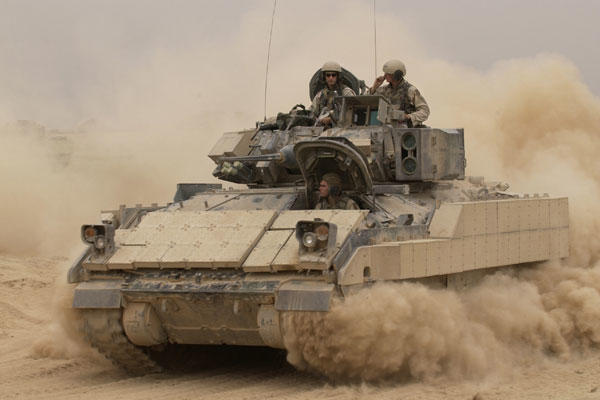U.S. Army officials say defense spending cuts killed the Ground Combat Vehicle, but this latest modernization setback fits right into the service's growing portfolio of failed attempts to replace its Cold War vehicles and helicopters, defense experts said.
All of the services are struggling with across-the-board spending cuts under sequestration, but ground systems make up a tiny share of the Pentagon's budget for major weapons acquisition programs.
The Defense Department plans to spend more than $54 billion on major weapons systems in fiscal 2015, which begins Oct. 1, according to budget documents. The majority of that -- about 70 percent -- would go toward aircraft and maritime systems, from the F-35 Joint Strike Fighter and the P-8A Poseidon naval patrol plane, to the Virginia-class submarine and Aegis-class destroyer.
Just $1 billion of the overall total, or about 2 percent -- the lowest percentage of any category for acquisition programs -- would go toward ground systems. Indeed, the ground system slated to receive the most funding next year is the Abrams tank, which was barely used in the past decade in Afghanistan. The Army plans to spend $350 million upgrading M1A2 versions of the main battle tank.
The budget officially kills the Ground Combat Vehicle, the Army's high-priority modernization program to replace the M2 Bradley Fighting Vehicle. Lawmakers in January cut GCV funding by $492 million, or 83 percent, bringing development to a halt.
Army acquisition officials maintain that the GCV was doing well, but the service simply couldn't afford it in this fiscally unforgiving climate.
"It's strictly the fact we don't have the money," said Heidi Shyu, the Army's chief acquisitions official. "Even if you cut 100,000 troops today, you can't squeeze out the money."
The Army is already cutting its active force from its current end strength of 520,000 soldiers down to 440,000-450,000 and possibly even further to 420,000 unless sequestration is repealed.
But defense experts aren't buying it. They have heard the Army tell this story again and again. Programs such as the XM2001 Crusader self-propelled howitzer, the RAH-66 Comanche scout helicopter and the sophisticated Manned Ground Vehicles family under the Army's Future Combat Systems effort suffered the same fate as the GCV.
"What we see today is an Army modernization strategy that consists mainly of just warming over weapons from the Reagan era," said Loren Thompson, head of the Lexington Institute, referring to systems such the AH-64 Apache and UH-60 Black Hawk helicopters as well as the Abrams tank and the Bradley Fighting Vehicle fielded during Ronald Reagan's presidency.
"It seems that that was the last time the Army was really in control of its fate. ... Some problem has afflicted the Army acquisition community since the Cold War ended and made it impossible to stick with a plan," Thompson said.
To Todd Harrison of the Center for Strategic and Budgetary Assessments, the Army places too much of a priority on maintaining end strength.
"The model in the Army, and Marine Corps for that matter, is you equip the man," he said. "And in the Air Force and the Navy, you man the equipment. ... You do everything to protect your end strength, and to do that, you sacrifice your modernization."
Part of the problem is the Army can't seem to come up with compelling reasons for its modernization programs.
"What do you really need that is different from a Bradley?" Harrison asked. Army officials argued that the Bradley is ineffective since it cannot carry a full, nine-man, infantry squad -- the most basic element in Army maneuver.
"The Army gets told to make do with what it's got ... the Air Force doesn't," Harrison said.
But that doesn't mean Air Force modernization hasn't suffered its share of setbacks, Thompson said, pointing to the decision to slash the number of F-22 Raptors in the Air Force fleet. He also mentioned the road blocks with the Next Generation Bomber and the Combat Search and Rescue Helicopter, as well as the decision to cancel the Airborne Laser program.
The Army's failure to land modernization programs should be blamed on the service's approach to acquisition, Thompson said.
He points to the funding cuts to the Armed Aerial Scout (AAS) helicopter program.
"That was the third time that the Army tried to replace the OH-58 Kiowa helicopter in 20 years," Thompson said. "First it was the Comanche, then it was the Armed Reconnaissance Helicopter, then it was AAS. A huge amount of money was spent and companies worked hard to come up with solutions and yet one by one, every one of them failed.
"The implication of these repeated failures to field priority combat systems suggests the Army simply doesn't value acquisition training and execution very highly."
The average acquisition officer stays in a job for two to three years, said Thompson, who is convinced it's not enough time to learn anything or remember mistakes from the past.
With the GCV, "the amazing thing is that this idea for a 60-70 ton, oversized troop carrier came from the same service that 10 years earlier was saying that its next troop carrier had to be flown on a C-130," Thompson said, referring to a key requirement of the Manned Ground Vehicles program under FCS.
"I think the Army needs to convince itself that having competent senior officers in the acquisition field that stay in the same job for four or five or six years will ultimately strengthen the institution."
-- Military.com Managing Editor Michael Hoffman and Associate Editor Brendan McGarry contributed to this story.
-- Matthew Cox can be reached at Matthew.Cox@monster.com



























